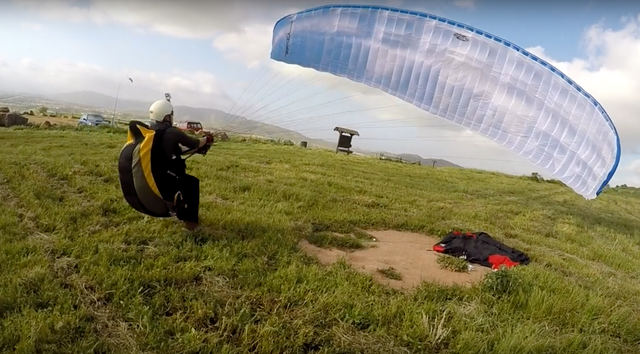How important is "Ground handling" in paragliding?
The most fundamental part of flying in the air, knowing how to get your aircraft off the ground successful.
The winds were gusting between 15-20 MPH. This wing wants to fly, you just have to figure out what strings to pull. Easy enough right?

There are many paraglider pilots who will agree that this is the single most important practice that you can do to understand your wing. Ground handling or kiting is like flying a kite, that is strapped to your body. The good news is that if you do it right you can fly. Bad news is if you do it wrong, it can fly-swat you on the ground and send you home to be with Jesus.
There are hundreds of videos in the YouTube archives on this subject.
- In Europe, most of the guys who paraglide professionally fly using whats called, "forward launch". This is widely acceptable in Europe. Most of the time, these guys have a very small launching zone. From what I am gathering, the "Reverse launch" technique is more popular here in the states.

I would say, that if you are going to be incredible at flying, the answer is yes!
I prefer the reverse launch, because using this technique, you can see your lines, the wing, and the direction of the wind. These are all very important things to look at before you suspend your body hundreds and sometimes thousands of feet off of the ground.
In the video below, I had very little experience in ground handling.
If you want to know more about the ground handling subject in paragliding, check out the link below.
Some truly great content about the subject.
Check out @paleotreats here on steemit. He was the one conducting the interview in this podcast.
http://www.cloudbasemayhem.com/episode-37-the-groundhandling-podcast/

Nice dude! It's mastery of the fundamentals that is simultaneously the most important and most ignored aspect of achieving excellence. Get 'em!
Thanks!
I could see how it could yank a person real quick. Great post!
No doubt
A saying I kept hearing off the old pilots when I was training was 'flying's the easy bit, taking off and landing are the hard parts' lol.
Reverse launch for me :) Such small hills where I live means that if conditions are conducive for a forward launch (no wind - to - very light winds) then I'll only be gliding straight down on a short flight. I only tend to head out to the hills when I know there's a good chance of remaining aloft.
Nice post Cap't, those interested in taking up the sport probably don't realise the importance of kiting skills.
I am looking forward to the day when the #paragliding is popular enough to make it on the list. I think we may have enlisted another pilot the last time myself and @paleotreats were flying together.
Excellent :) The more the merrier. My last few YouTube videos (admittedly bushcraft related) I have added my steemit address in description box but no one seems to be interested. I'm guessing like I was a month ago, no one has heard of Steem.
As a novice pilot it took me a while to realize how weak I was at kiting - when you're learning you're often in a rush to get in the air and get flight numbers and hours checked off. Once I started trying to kite on my own with no one else around me and no instructor I found I just didn't have the skills I needed to be good at it. Even if one of those skills was when not to even try to bring up the wing (plus this was 14 years ago with a crappy 1999 design wing that was super heavy and slow as a bus). I then devoted a lot of time to getting much, much better at kiting (I wouldn't say mastering). If there is one thing I hear more advanced pilots say it is "I don't kite enough" (and the other is "I really should do an SIV course").
Even after thinking I'd nailed kiting, years later a bad habit I'd developed caused me to have a serious accident which combined with equipment failure could easily have killed me or left me a vegetable.
My mantra now is "Always be kiting and always be learning!"
Did you get picked up on launch? Or what happened?
I took off in high wind and was not able to penetrate and was not able to get to my speedbar easily so I landed. When trying to bring the wing down I reached for the brakes underestimating the potential for a drag. I also had left my gloves in the car and was not able to pull lines in. I got yanked off my feet, pulled sideways and hit my head going backwards.
I came around about 40 minutes later being strapped onto a back board and loaded into a helicopter. My full face helmet plastic buckle had broken at some point, the helmet came off and my face was dragged a few hundred feet over rocks, mud and grass.
I only broke two bones - my nose and the interior bone under my left eye which is no permanently dilated due to the impact. I was a bloody mess but lived to tell the tale.
Wow! That is rough! Glad you are ok. That could have been the end. Thanks for sharing that. Do you still fly?
Yes, I got back to flying a couple of months after the accident. My neck got very beaten up from the accident - major whiplash I guess - and to this day I have issues looking around. But it is good to be alive and flying even if I still have some major angst when the wind is strong. But I force myself to kite and be very aggressive in killing the wing with Cs, like my life depended on it - which I now know it does.
Glad you were wearing gloves for this - I've noticed some quite a few of your other videos you aren't. Gloves when it is warm are like a helmet - don't do anything until you need them but when you need them you'll be really glad you had them. And always get ones that aren't going to friction burn to your burn - just like your skin does.
I put my gloves in my back pocked after my first launch, the problem was one of them fell out of my pocket on the trail and I didn't go back for it. So now I fly with one black one and one red one. LOL.